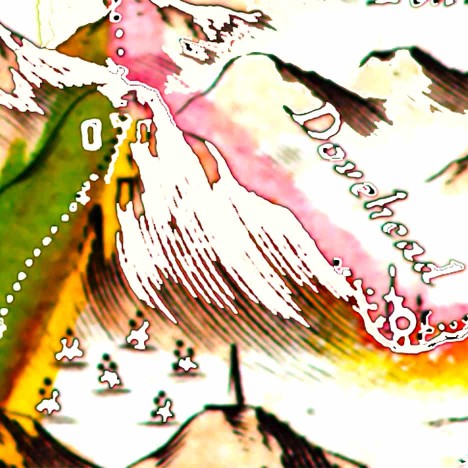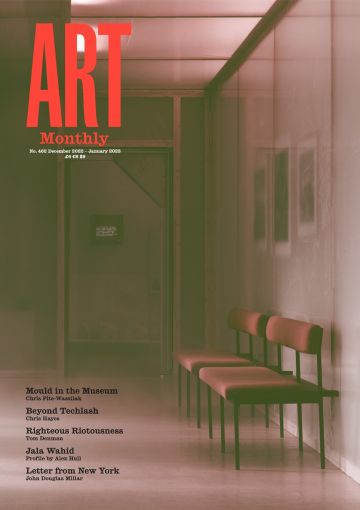Review
Roy Claire Potter: Land Lay Moldbrest • David Steans: Mummy Hood Nesting Forest
Jamie Sutcliffe is consumed by two new net art commissions that explore landscape horror through hypertext

Roy Claire Potter, Land Lay Moldbrest, 2022
Has British natural history writing mellowed into a self-assuredly cosy and innocuous affair? From the work of its most seasoned sages to its greenest scribes, digitally emulated woodblock prints and charming watercolours reliably embellish the covers of the genre’s burgeoning literature, graphically alluding to lost agrarian intimacies and disappearing trades. While the writing itself might seek to soothe modern anxieties with promised excursions into untarnished ‘wild places’ and ‘trespassings’ in pursuit of ‘common ground’, it has become increasingly difficult to overlook the field’s bourgeois phrasings, let alone its formulaic narratives of curative reconnection with a receding rurality.
Elegiac reminiscence and genteel word-smithery are the stock-in-trade of this milieu; its botanical litanies and sylvan reveries rarely questioned as affectations of the ambient lyrical imperialism that they quietly, yet irrefutably, are. How bracing, then, to encounter two new works of writing by artists that frustrate the very presumption of language’s ability to account for the topographical and experiential oddities of the rural, while retaining an honest and darkly humoured sense of wonder at its unassimilable immensities.
Supported as a part of their artist-focused approach to project development, yet released as something of an experimental excursion into online programming by Nottingham’s Primary, Land Lay Moldbrest by Roy Claire Potter and Mummy Hood Nesting Forestby David Steans (both works 2022) are fastidiously crafted narratives that pitch their explorations of landscape against novel mechanics of distribution.
Steans’s Mummy Hood Nesting Forest is both a short work of fragmentary fiction and an absurd product of a marketing campaign recounting the fates of three hapless hikers – Lantern, Bookworm and Night Light – and their over-designed outdoors apparel. It is a labyrinthine, Beckettian romp, a comic yet ultimately disquieting read that besmirches the hyperbolic rhetoric of outdoor ‘tech-wear’ with harrowing tales of missing walkers and their rotten remains, phantom dogs and viscous residues. Published on a strikingly bespoke website, the work encourages its readers to ‘get lost’ via the page’s intentionally unwieldy navigation, a process encouraged by the text’s circuitous narrative pathways.
Harking back to that strange era of proto-web-2.0 site design in which cryptic hyperlinks and elusive content were often deployed as atmospheric intensifiers rather than direct conduits to information, Steans’s site recalls the uneasy viral marketing campaigns of cult films, such as The Blair Witch Project, 1998, or Dennis Cooper’s recent .gif novels, such as Zac’s Haunted House, that creatively obstruct user engagement. Here, animated flies spawn in abundance, clustering around the user’s cursor until their dark cloud obfuscates the page. Links rarely remain in place but slide creepily down the screen. This data isn’t functional, it’s an icky mess, a festering petri dish of decaying ‘user experience’ tropes, further destabilised by a looping soundtrack of reverb heavy guitar, dampened bodhran drubs and spare eldritch foley, which is reminiscent of both the orchestrated noodlings of Claudio Simonetti’s horror super group Goblin (famed for their soundtrack to Dario Argento’s 1977 Suspiria) and the wallowing orcish gamelan of northern noise outfit Metgumbnerbone.
Previous works by Steans have demonstrated a preoccupation with the uncanny resonances of new media, both in terms of their technological weirdness but also their osmotic narrative affordances. Where his 2020 anti-film Puppy the Goblin implicated the observer in an act of paranoiac mesmerism by subtly eroding the distance between narrator, viewer and the film’s eponymous monster, Mummy Hood Nesting Forest works to absorb the reader by incorporating echoes of their browsing disorientations directly into the story, effectively zipping them into the same soiled sleeping bag as its confused characters.
Following media historian Jeffrey Sconce, we might characterise these techniques as exercises in ‘technical delusion’, simulations of electronic paranoia that tease underlying technological anxieties from our encounters with otherwise ubiquitous media platforms. ‘Some trips you don’t come back from,’ Steans’s story warns, perhaps alluding to the perils of trail walking. But it’s also tempting to think of the artist’s works in the broader sense of ‘tripping’, where the sticky, affecting stuff of narrative clings to our boots like an unshakably thick mud, a psychological residue with a similar viscosity and destabilising sense of self to the memory of a hallucinogenic encounter.
The beautifully cryptic title of Roy Claire Potter’s Land Lay Moldbrest instantly sets a curious tone and agenda for their experimental audio book; ‘Moldbrest’ is a Yorkshire archaism supposedly meaning an ‘uncultivated land’, although any clear definition seems lost to time. Set atop the moorlands, edges and fells of the Pennine Way, what at first appears to be the narrativised ramblings of a walker surveying the old bridleways and packhorse routes of a weather-blasted landscape gradually reveals itself through Potter’s performed prose as a series of cautious lexical unearthings and inheritances, a writing that carefully interposes itself between landscape, history and body.
Recounting the ambulatory and annotative wanderings of the story’s protagonist – a solitary, initially solipsistic character we come to know simply as Walker – Potter enunciates the simultaneous erosion and repurposing of both place and language. Old trade routes have become leisure hikes, ancient ruins the bequeathed piles of racist landlords. Walker’s compulsion to walk is matched only by their impulse to write; a topographical automatism through which itinerant intimacies with the landscape are felt and recorded in hope of some connection with history, with place, with people. The mania of this writing eventually leads to an encounter late one night with a disembodied voice that utters a lyrical keystone of sorts, the antiquated regional term for a peddler, a ‘Jagger’. And it’s through this spectral history of wayfaring labour that the principle of movement, trade and exchange seems to allow Walker to see beyond the instrumentalised heritage of enclosed lands and private estates to a more unifying legacy of the landscape in its contemporary migrant and undocumented populations.
‘My body cold. Jagger, I hear called back. A low voice, a nearing voice. Panic, for the tent zip. Turn, knock the bottle, Jagger once more but inside, how inside, fabric soaked, water gone, where is voice, where is, how close, hear it breathe, feel it say – Come, Note Taker, find me.’ It’s testament to Potter’s lyrical and performative deftness that these words somehow oscillate between the reassuring affability of Robert Wyatt’s spoken songs and the vertiginous challenges of L=A=N=G=U=A=G=E poetry, between the nourishing fables of Alan Garner and the yearning poetics of John Giorno. While intermittent harmonium melodies and warm piano signatures, somewhat reminiscent of Ivor Cutler’s narrative vignettes, intersperse their reading, Potter’s stories ultimately lead us somewhere very different, to fogged moorlands in which language’s claims to mastery become diffused by the edifying contingencies of not knowing.
Roy Claire Potter’s Land Lay Moldbrest and David Steans’s Mummy Hood Nesting Forest were commissioned by Primary, Nottingham, more details can be found at weareprimary.org
Jamie Sutcliffe is a writer and curator and co-director of Strange Attractor Press.
First published in Art Monthly 462: Dec-Jan 22-23.


